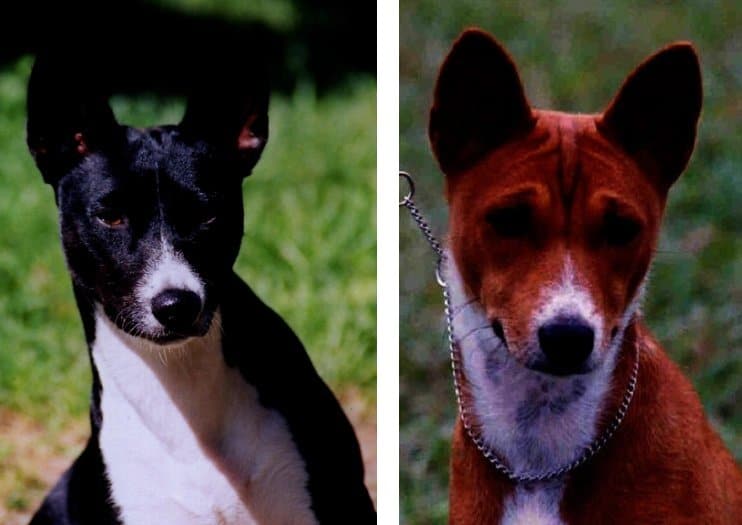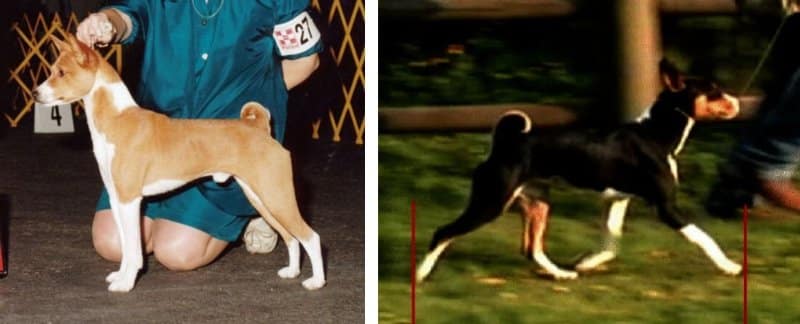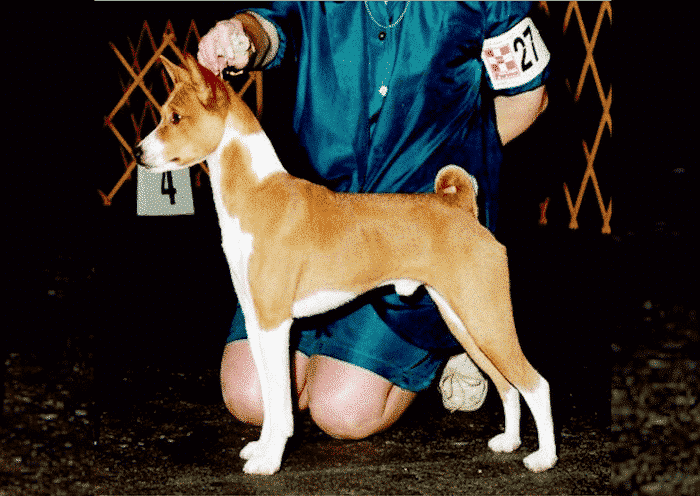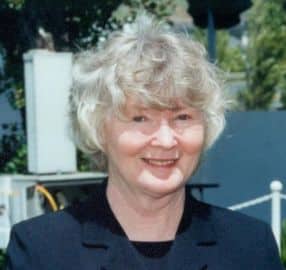Judging the Basenji
The Basenji is one of only a few breeds on earth in which healthy populations of indigenous native stock can be accessed and bred into AKC domestic populations. The American Kennel Club has allowed us to re-open our stud book on a temporary basis and incorporate carefully selected and rigorously evaluated native African Basenjis into our breeding programs. Several expeditions composed of intrepid Basenji fanciers have already made the long trek to central Africa to bring back native Basenjis, and more deep-jungle safaris are currently planned. This is an exciting time for Basenji enthusiasts and judges alike who are intrigued by these enchanting African imps.

This is an ancient breed, long-prized as silent hunters by tribesmen in remote areas of central Africa. The hunting dogs have lived in the villages with the families, played with the children, and slept in the huts at night. Living in isolation, the dogs would be protective of the villagers and naturally aloof with strangers.
A typical hunt takes place in the dense jungle where long nets are stretched out by experienced hunters who wait with sharpened spears for approaching game flushed by the pursuing dogs. Basenjis do not hunt in organized packs, but are more like independent contractors who move at breakneck speed through virtually impenetrable brush, wearing hand-fashioned hunting bells around their necks so that the hunters can track the individual dogs at all times. Their working gait is a series of lightning fast leaps and bounds through tangled undergrowth. The dogs must be small and agile enough to traverse the jungle, yet strong enough to push through nearly impassable thickets when necessary, while not getting hung up in the dense cover.

This is an ancient breed, long-prized as silent hunters by tribesmen in remote areas of central Africa.
When you judge the Basenji, you will be looking for a dog which is not only capable of performing his ancestral duties but is capable of surviving the experience as well. The Basenji Breed Standard was well-written to describe such a dog—a natural hunter.
When a class enters your ring, your first impression should be that of square, fine-boned, leggy dogs with the grace of gazelles. The clumsy, cloddy Basenji should not make it past your first cut. Toplines should be level, necks should be well-arched, curly tails should be high-set, angulation should be moderate and balanced, and front fill is a necessity.
Movement is light and effortless and should put you in mind of a highly-bred Thoroughbred horse, joyfully skimming the earth while out for an afternoon jaunt. These dogs can go all day and come back for more. Inefficient movement is wasteful and dangerous for a dog whose life may depend on his ability to avoid a deadly predator at a moment’s notice.
The breed may be known for its wrinkles and curly tails, but there is a lot more to a Basenji than the emphasis on these two features alone would indicate. The wrinkles on the head serve as a hallmark that the skin on the body is sufficiently fine and loose; a requirement for a dog that needs to make its way unimpeded and unharmed at speed through coiled vines and thorny shrubbery. And that curly tail must be set high for the dog’s rear construction to be correct; even though we love our triple-curled donut tails, we would much rather see a high-set single curl than a low-set multiple-curled tail.

Heads are distinctive and do not look like any other breed. Ears are set high on the head and carried erect when the dog is alert. They can be carried back when the dog is relaxed, expressing affection, or dozing. Eyes are dark, almond-shaped, obliquely set, and surmounted by a distinct brow; they do not stare forward with a piercing gaze. The skin is fine and loose enough to form wrinkles on the forehead when the ears are up, but not so loose that it hangs in folds as a dewlap. Side wrinkles are desirable but, sadly, in short supply these days. The muzzle is very definitely shorter than the skull, and a very untypical look is created when these proportions are equal, or even, heaven forbid, reversed.
Basenjis come in a variety of wonderful colors which include a rich chestnut red, pure black, tricolor, and brindle; a brindle-pointed tricolor will have black stripes in the areas of red, and this coloration is not to be faulted. All colors are smartly accented by a white chest, four white feet and a white tip on the tail. Additional white in the form of facial blazes, stockings, and full or partial collars may be attractive but are not required. Full white collars may further the illusion of a longer neck on dogs so marked and are sometimes favored by exhibitors.
The Basenji ring is a pretty cheerful place to be, as we encourage judges to greet both our dogs and our exhibitors with a friendly smile. They should return the favor.

But there are two things we ask of every judge. Do not even think about uncurling the tail as this may startle the dog and can even be painful for some individuals. And please, when you’re in the ring judging, don’t ever try to sneak up on a Basenji. A stealthy approach may well find them examining your credentials and you will be found lacking.
There are some very useful breed-specific examination techniques which can be employed to make your judging experience more pleasant and much more fruitful overall. View the dog on the table briefly from the side to get an idea of general appearance and proportion (think “square”) and then approach the dog from the front and extend your hand smoothly and with confidence. Eye contact is good, as long as it is accompanied by a smile. Helpful hint: our dogs are extremely food-oriented and our exhibitors carry lots of bait. They will not mind at all if you should ask to borrow a piece of liver to entice a restless or reluctant exhibit into a happier state of mind.
Check bite, eye shape and placement, do a quick once over to check musculature and skin and coat quality, and check testicles, as appropriate. That’s all. No need to run elaborate measuring routines or poke and prod this smooth-coated dog excessively. As always, examine on the table but judge on the ground. Ear set, wrinkle, and expression are much better observed on the ground and the exhibitor is more than ready to show them to you at the end of the down and back. Tail set and curl are usually better on the move and the topline is more natural as the exhibitor is not able to poke the tummy or stretch the rear legs back to disguise failings in that area. Do not let the exhibitors race around the ring; a properly constructed Basenji looks just fine at a moderate pace.
Lastly, and most unfortunately, Basenji males are notorious for retracting their testes in cold weather. If this happens, complete your examination, have the exhibitor take the dog off the table, gait him normally, and then put him back on the table for a re-check. This may help, but if two normal testicles still cannot be located, you have no choice but to disqualify. As Basenjis are quite often scheduled to be shown at the crack of dawn, with cold, wet dew still on the grass, be aware that this is a possibility.
The Basenji Club of America has devoted considerable time and expertise to educational efforts on our website. Please visit us for lists of helpful mentors and volumes of historical and current information about this delightful breed.
Our rotating National Specialty will be held this year at Argus Ranch in Auburn, Washington, from August 7-11. Please join us there for a Basenji Extravaganza! You may contact me at [email protected] with any questions and for further information.














